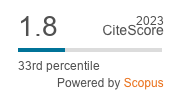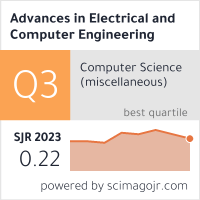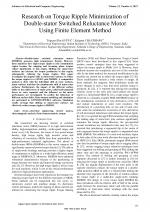| 4/2021 - 15 | View TOC | « Previous Article | Next Article » |
Research on Torque Ripple Minimization of Double-stator Switched Reluctance Motor Using Finite Element MethodDas GUPTA, T. |
| Extra paper information in |
| Click to see author's profile in |
| Download PDF |
Author keywords
electrical engineering, electric motors, electromagnetic analysis, finite element analysis, torque
References keywords
switched(20), reluctance(20), torque(13), motor(11), ripple(8), research(7), progress(6), electromagnetics(6), double(6), design(6)
Blue keywords are present in both the references section and the paper title.
About this article
Date of Publication: 2021-11-30
Volume 21, Issue 4, Year 2021, On page(s): 135 - 144
ISSN: 1582-7445, e-ISSN: 1844-7600
Digital Object Identifier: 10.4316/AECE.2021.04015
Web of Science Accession Number: 000725107100015
SCOPUS ID: 85122266863
Abstract
Double-stator switched reluctance motors (DSSRMs) possesses high torque/power density. However, these machines have high torque ripples in the commutation region because the outgoing and incoming phase torques reduce significantly in this region. Shifting the stator/rotor surfaces can increase the torque production in this region, subsequently reducing the torque ripples. This paper investigates the angular shift in stator/rotor surfaces to reduce the torque ripples in a 12/10/12 pole DSSRM. A comparative analysis is done with the individual shift of rotor surfaces, stator surfaces and then the simultaneous shift of stator-rotor surfaces. Furthermore, the impact of the different surface shifts on the radial stress of stator poles, radial and tangential forces on rotor segments and the influence on the motor performance are investigated. To predict the behaviour of different surface shifts, finite-element modeling and simulation are performed in ANSYS/MAXWELL software. Simulation results envisage that shifting in stator/rotor surfaces can effectively reduce torque ripples in DSSRM. |
| References | | | Cited By «-- Click to see who has cited this paper |
| [1] K. S. Sree Ranjini, S. Murugan, "Design and performance comparison of permanent magnet brushless motors and switched reluctance motors for extended temperature applications," Progress in Electromagnetics Research M, vol. 67, pp. 137-146, 2018. [CrossRef] [SCOPUS Times Cited 8] [2] H. Abdelmaksoud, M. Zaky, "Design of an adaptive flux observer for sensorless switched reluctance motors using lyapunov theory," Advances in Electrical and Computer Engineering, vol.20, no.2, pp.123-130, 2020. [CrossRef] [Full Text] [Web of Science Times Cited 6] [SCOPUS Times Cited 7] [3] D. Vukadinovic, S. Grbin, M. Basic, "Experimental method of determining the equivalent circuit Parameters of a switched reluctance machine," Advances in Electrical and Computer Engineering, vol.15, no.3, pp.93-98, 2015. [CrossRef] [Full Text] [Web of Science Times Cited 4] [SCOPUS Times Cited 3] [4] M. Polat, A. Yildiz, "Influence of different pole head shapes on motor performance in switched reluctance motors," Advances in Electrical and Computer Engineering, vol.20, no.3, pp.75-82, 2020. [CrossRef] [Full Text] [Web of Science Times Cited 6] [SCOPUS Times Cited 10] [5] M. Abbasian, M. Moallem, B. Fahimi, "Double-stator switched reluctance machines (DSSRM): Fundamentals and magnetic force analysis," IEEE Trans. Energy Convers., vol. 25, no. 3, pp. 589-597, Sep. 2010. [CrossRef] [Web of Science Times Cited 142] [SCOPUS Times Cited 167] [6] E. Cosoroaba, E. Bostanci, Y. Li, W. Wang, B. Fahimi, "Comparison of winding configurations in double-stator switched reluctance machines," IET Electr. Power Appl., vol. 11, no. 8, pp. 1407-1415, 2017. [CrossRef] [Web of Science Times Cited 12] [SCOPUS Times Cited 15] [7] E. Bostanci, M. Moallem, A. Parsapour, B. Fahimi, "Opportunities and challenges of switched reluctance motor drives for electric propulsion: A comparative study," IEEE Trans. Transport. Electrific., vol. 3, no. 1, pp. 58-75, Mar. 2017. [CrossRef] [Web of Science Times Cited 276] [SCOPUS Times Cited 377] [8] Y. Jin, B. Bilgin, A. Emadi, "An offline torque sharing function for torque ripple reduction in switched reluctance motor drives," IEEE Trans. Energy Convers., vol. 30, no. 2, pp. 726-735, Jun. 2015. [CrossRef] [Web of Science Times Cited 214] [SCOPUS Times Cited 264] [9] R. B. Inderka, R. W. A. A. De Doncker, "DITC-direct instantaneous torque control of switched reluctance drives," IEEE Trans. Ind. Appl., vol. 39, no. 4, pp. 1046-1051, 2003. [CrossRef] [Web of Science Times Cited 236] [SCOPUS Times Cited 301] [10] C. Chen, H. Guo, G. Zhang, "SOSM direct torque and direct suspension force control for double stator bearingless switched reluctance motor," Progress in Electromagnetics Research C, vol. 96, pp. 179-192, 2019. [CrossRef] [SCOPUS Times Cited 5] [11] Q. Li, A. Xu, L. Zhou, C. Shang, "A deadbeat current control method for switched reluctance motor," Progress in Electromagnetics Research Letters, vol. 91, pp. 123-128, 2020. [CrossRef] [Web of Science Times Cited 2] [SCOPUS Times Cited 5] [12] C. Sahin, A. E. Amac, M. Karacor, "Reducing torque ripple of switched reluctance machines by relocation of rotor moulding clinches," IET Electric Power Applications, vol. 6, no. 9, pp. 753-760, Nov. 2012. [CrossRef] [Web of Science Times Cited 42] [SCOPUS Times Cited 48] [13] G. Li, J. Ojeda, S. Hlioui, "Modification in rotor pole geometry of mutually coupled switched reluctance machine for torque ripple mitigating," IEEE Trans. Magn., vol. 48, no. 6, pp. 2025-2034, 2012. [CrossRef] [Web of Science Times Cited 92] [SCOPUS Times Cited 117] [14] Y. Li, S. Ravi, D. C. Aliprantis, "Tooth shape optimization of switched reluctance motors for improved torque profiles," in IEEE International Electric Machines & Drives Conference (IEMDC), 2015, pp. 569-575. [CrossRef] [SCOPUS Times Cited 12] [15] M. A. Kabir, I. Husain, "Segmented rotor design of concentrated wound switched reluctance motor (SRM) for torque ripple minimization," in IEEE Energy Conversion Congress and Exposition (ECCE), 2016, pp. 1-6. [CrossRef] [SCOPUS Times Cited 12] [16] L. Jing, J. Cheng, "Research on torque ripple optimization of switched reluctance motor based on finite element method," Progress in Electromagnetics Research M, vol. 74, pp. 115-123, 2018. [CrossRef] [Web of Science Times Cited 5] [SCOPUS Times Cited 9] [17] M. Aydin, Z. Q. Zhu, T. A. Lipo, D. Howe, "Minimization of cogging torque in axial-flux permanent-magnet machines: Design concepts," IEEE Trans. Magn., vol. 43, no. 9, pp. 3614-3622, 2007. [CrossRef] [Web of Science Times Cited 144] [SCOPUS Times Cited 190] [18] R. Madhavan, B. G. Fernandes, "Performance improvement in the axial flux-segmented rotor-switched reluctance motor," IEEE Trans. Energy Convers., vol. 29, no. 3, pp. 641-651, Sep. 2014. [CrossRef] [Web of Science Times Cited 52] [SCOPUS Times Cited 61] [19] M. J. Kermanipour, B. Ganji, "Modification in geometric structure of double-sided axial flux switched reluctance motor for mitigating torque ripple,'' Can. J. Electr. Comput. Eng., vol. 38, no. 4, pp. 318-322, Fall 2015. [CrossRef] [Web of Science Times Cited 25] [SCOPUS Times Cited 31] [20] T. D. Gupta, K. Chaudhary, R. M. Elavarasan, R. K. Saket, I. Khan, E. Hossain, "Design modification in single-tooth winding double-stator switched reluctance motor for torque ripple mitigation," IEEE Access, vol. 9, pp. 19078-19096, 2021. [CrossRef] [Web of Science Times Cited 15] [SCOPUS Times Cited 30] [21] T. D. Gupta, K. Chaudhary, "Finite element method based design and analysis of a low torque ripple double-stator switched reluctance motor," Progress in Electromagnetics Research C, vol. 111, pp. 191-206, 2021. [CrossRef] [SCOPUS Times Cited 9] [22] H. Torkaman, E. Afjei, "Radial force characteristic assessment in a novel two-phase dual layer SRG using FEM," Progress in Electromagnetics Research, vol. 125, pp. 185-202, 2012. [CrossRef] [Web of Science Times Cited 10] [SCOPUS Times Cited 12] [23] A. Simion, L. Livadaru, S. Mihai, A. Munteanu, C. G. Cantemir, "Induction machine with improved operating performances for electric trucks. A FEM-based analysis," Advances in Electrical and Computer Engineering, vol.10, no.2, pp.71-76, 2010. [CrossRef] [Full Text] [Web of Science Times Cited 5] [SCOPUS Times Cited 7] Web of Science® Citations for all references: 1,288 TCR SCOPUS® Citations for all references: 1,700 TCR Web of Science® Average Citations per reference: 54 ACR SCOPUS® Average Citations per reference: 71 ACR TCR = Total Citations for References / ACR = Average Citations per Reference We introduced in 2010 - for the first time in scientific publishing, the term "References Weight", as a quantitative indication of the quality ... Read more Citations for references updated on 2025-05-31 13:56 in 154 seconds. Note1: Web of Science® is a registered trademark of Clarivate Analytics. Note2: SCOPUS® is a registered trademark of Elsevier B.V. Disclaimer: All queries to the respective databases were made by using the DOI record of every reference (where available). Due to technical problems beyond our control, the information is not always accurate. Please use the CrossRef link to visit the respective publisher site. |
Faculty of Electrical Engineering and Computer Science
Stefan cel Mare University of Suceava, Romania
All rights reserved: Advances in Electrical and Computer Engineering is a registered trademark of the Stefan cel Mare University of Suceava. No part of this publication may be reproduced, stored in a retrieval system, photocopied, recorded or archived, without the written permission from the Editor. When authors submit their papers for publication, they agree that the copyright for their article be transferred to the Faculty of Electrical Engineering and Computer Science, Stefan cel Mare University of Suceava, Romania, if and only if the articles are accepted for publication. The copyright covers the exclusive rights to reproduce and distribute the article, including reprints and translations.
Permission for other use: The copyright owner's consent does not extend to copying for general distribution, for promotion, for creating new works, or for resale. Specific written permission must be obtained from the Editor for such copying. Direct linking to files hosted on this website is strictly prohibited.
Disclaimer: Whilst every effort is made by the publishers and editorial board to see that no inaccurate or misleading data, opinions or statements appear in this journal, they wish to make it clear that all information and opinions formulated in the articles, as well as linguistic accuracy, are the sole responsibility of the author.



